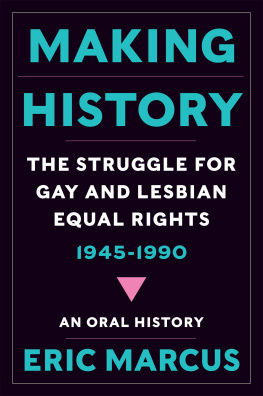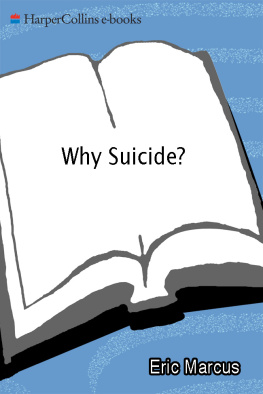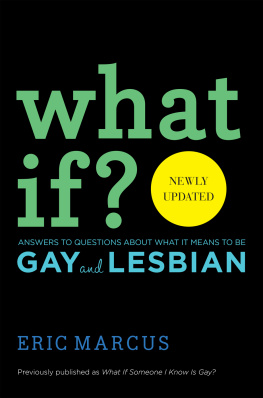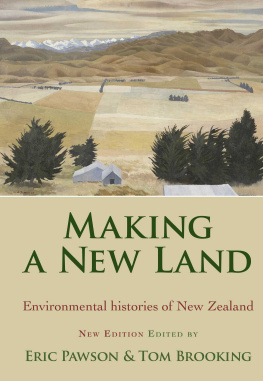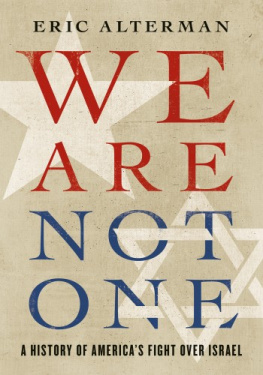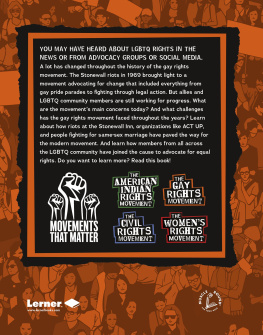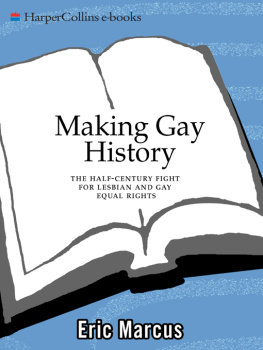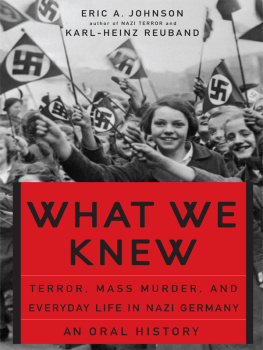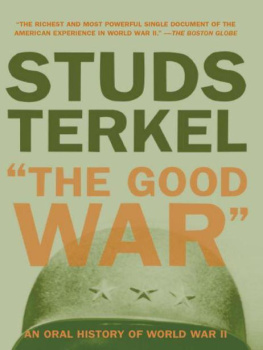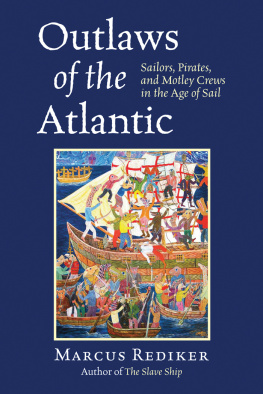Contents
To my mother, Cecilia Marcus, and grandmother, May Sperling Marcus. And for Homer, again.
When the dust settles and the pages of history are written, it will not be the angry defenders of intolerance who have made the difference. That reward will go to those who dared to step outside the safety of their privacy in order to expose and rout the prevailing prejudices.
John Shelby Spong, Episcopal Bishop of the Diocese of Newark, New Jersey
The struggle for gay and lesbian equal rights did not begin on June 28, 1969, with a riot at New York Citys Stonewall Inn. This misconception has been reflexively asserted in both the gay and mainstream press so often and for so many years that it would seem to be an unassailable fact.
Perhaps claiming the Stonewall riot as the birthplace of the struggle for gay rights is a necessary misconception. It offers the benefit of a clean starting point, an easy line of demarcation: Before Stonewall; after Stonewall. And it was an explosive and undeniably significant moment in history in which we can all take pride; gay people fought back against police repression. But there were many earlier confrontations, breakthroughs, and defining moments. By investing so much in Stonewall, we have elevated this one event to mythic status, diminishing all that came before and tying all that has happened since to a single point of origin.
In Making History, the Stonewall riot takes its place as part of a rich, heartbreaking, and ultimately heroic forty-five-year struggle for gay and lesbian equal rights in the United States.
I have divided the story of the struggle for gay and lesbian equal rights into five parts. Part 1, covering 1945 to 1961, introduces men and women who were involved in the first gay and lesbian discussion groups and organizations in the years following World War II. They include a woman who in 1947 published the first lesbian newsletter (from her office typwriter) and a heterosexual psychologist who made the very radical claim, for 1956, that there were no discernable psychological differences between gay men and heterosexual men.
Part 2, 1961 to 1968, covers the rise of the homophile movement of the 1960s, which paralleled and gained inspiration from the black civil rights movement. The men and women in this section participated in some of the first public protests by gay people and were involved in a major confrontation with police at a fund-raising event in San Francisco in 1965.
Part 3, 1968 to 1973, covers the turbulent, divisive years of gay liberation, which was strongly influenced by the rise of leftist and anti-Vietnam War activism in the late 1960s. This period was marked by a dramatic increase in the number of people and organizations involved in the gay rights struggle; a significant shift in goals and tactics; and swift, if not complete or uniform, progress toward achieving equal rights.
Part 4, 1973 to 1981, tracks both a period of significant broadening of the gay rights effort and an antigay backlash.
Part 5 begins in 1981, the year the mainstream press first published news of a perplexing disease affecting gay men in Los Angeles, New York, and San Francisco. The stories in this final section demonstrate the impact that AIDS has had on gay and lesbian rights and on the lives of gay people. They also exemplify the achievements of the gay rights effort after forty-five years.
As I started my research for Making History, I was struck by the fact that the gay and lesbian rights effort has been almost entirely ignored by mainstream historians, biographers, textbook writers, and encyclopedias. For example, in the most recent edition of The Encyclopedia of American Facts and Dates, published by Harper & Row in 1988, there is no entry related to homosexuality until 1973. That entry is about two Houston teenagers who were indicted for the homosexual abuse and murder of twenty-seven people over a three-year period. This coverage is actually an improvement over standard high school American history textbooks, like Prentice Halls 1988 edition of The United States: A History of the Republic, in which gay men and lesbians are not even mentioned.
Fortunately, since the mid-1970s, a growing number of gay and lesbian historians, biographers, and journalists have begun to illuminate this dimension of American history. Their work served as the foundation for my research.
As I worked on Making History, I was constantly asked if I was going to include this or that well-known man or woman, usually individuals who had made important contributions to the struggle for gay rights. Almost without exception, I had to say no. The reason is simple: This is not a comprehensive history of the postwar struggle for gay and lesbian equal rights.
What I set out to do in this book is more modest. This is a selective oral history, an assortment of recollections representing a cross section of people, from high-profile leaders to little-known and largely forgotten contributors to the gay rights effort.
Early on, I was influenced by an essay on biography written by Lytton Strachey, the gay Bloomsbury writer, in the preface to his groundbreaking book Eminent Victorians:
It is not by the direct method of a scrupulous narration that the explorer of the past can hope to depict that singular epoch. If he is wise, he will adopt a subtler strategy. He will attack his subject in unexpected places; he will fall upon the flank, or the rear; he will shoot a sudden, revealing searchlight into obscure recesses, hitherto undivined. He will row out over that great ocean of material, and lower down into it, here and there, a little bucket, which will bring up to the light of day some characteristic specimen, from those far depths, to be examined with a careful curiosity.
Here and there I have lowered a bucket into the teeming and complex waters of the recent struggle for gay and lesbian equal rights. It is my hope that these few stories contribute to our understanding of that struggle and an appreciation of the life and times, the heroism, and the passion of the thousands of people who participated in it.
For the three years I worked on this book, many people told me what a wonderful idea it was. I agree, but Making History wasnt my idea. Rick Kot, my editor at HarperCollins, came to me in the summer of 1988 and asked me if I would be interested in taking on the project. I was interested, and Im grateful to Rick for his concept, encouragement, and editorial expertise during the years it took to get from idea to publication. Im also grateful to my agent, Eric Ashworth, for helping me get from idea to signed contract. And many thanks to my editors able assistant Sheila Gillooly.
For sharing research, background information, and contacts, I am indebted to Elver Barker, Allan Brub, Midge Costanza, Barbara Gittings, Jim Kepner, Morris Kight, Kay Lahusen, Phyllis Lyon, Del Martin, Craig Rodwell, Randy Shilts, Barbara Smith, Francis Smith, Manuela Soares, Tom Stoddard, Don Slater, and Randy Wicker. I am deeply indebted to historian John DEmilio, whose landmark book, Sexual Politics, Sexual Communities: The Making of a Homosexual Minority in the United States, 19401970, was my primary resource for the thirty-year period covered in his book. And many thanks to Bill Walker and the Gay and Lesbian Historical Society of Northern California for unlimited access to the societys library.
To my Columbia School of Journalism professors Dick Blood and Judy Serrin, thank you for teaching me the importance of spelling a name right the first time and the importance of thorough reporting. Im also grateful to Miriam Cohen, my history professor at Vassar College, for her sage advice on how to catalog and keep track of historical research.

